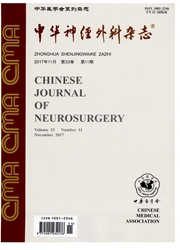

 中文摘要:
中文摘要:
目的观察亚低温对重型颅脑创伤诱导的Tau蛋白磷酸化的影响。方法体外研究通过细胞液压冲击仪建立SK—N—SH细胞损伤模型,观察冲击1h、6h和12h后Tau蛋白的磷酸化水平。体内研究通过小动物液压冲击仪建立大鼠重型颅脑损伤模型(2.4arm),接受或不接受亚低温治疗(33℃,4h)。观察液压冲击6h、24h和72h后Tau蛋白的磷酸化水平,以及亚低温对此变化的影响。结果sK—N—SH细胞在液压冲击后,Tau蛋白在Thr231和Ser396位点的磷酸化水平从lh开始升高,到6h左右达到高峰。sD大鼠在液压冲击后,Tau蛋白在Thr23l和Ser396位点的磷酸化水平从6h开始升高,到24h左右达到高峰,到72h仍处于高水平;免疫组化的结果也显示,大鼠脑部海马CAl区和皮质区的Tau蛋白磷酸化水平在Thr231位点也明显增高。亚低温可显著逆转液压冲击诱导的sD大鼠Tau蛋白过度磷酸化(P〈0.01)。结论亚低温可抑制重型颅脑创伤诱导的Tau蛋白过度磷酸化。
 英文摘要:
英文摘要:
Objective To investigate the effect of mild hypothermia on Tau hyperphosphorylation induced by severe traumatic brain injury (sTB1). Methods The in vitro injury model of SK - N - SH cells was established by the cell fluid percussion device. The phosphorylation of Tau at Thr231 or Ser396 was examined by western blot or fluorescent staining at 1 h, 6 h, or 12 h after injury. The in vivo injury model of SD rats was established by the rat fluid percussion device (2.4 arm). Mild hypothermia(33℃ ,4 h)was performed immediately after the injury. The phosphorylation of Tau at Thr231 or Ser396 was examined by western blot or fluorescent staining at 6 h, 24 h, or 72 h after injury. Results The phosphorylation of Tau at Thr231 and Ser396 in vitro was increased from 1 h and reached to the highest level at 6 h after the injury. The western blot showed that the phosphorylation of Tau at Thr231 and Ser396 in vivo was elevated from 6 h, reached to the highest level at 24 h, and still stay at a markedly higher level at 72 h after the injury. The immunohistochemistry also showed an obvious stain enhancement in CA1 and the cortex of injured brains. Mild hypothermia could significantly reverse the hyperphosphorylation of Tan at Thr231 and Ser396 induced by sTBI. Conclusion Application of mild hypothermia could significantly restore sTBI - mediated Tau hvoerohosohorvlation, which underlies a possible strategy for TBI related Alzheimer's Disease.
 同期刊论文项目
同期刊论文项目
 同项目期刊论文
同项目期刊论文
 期刊信息
期刊信息
